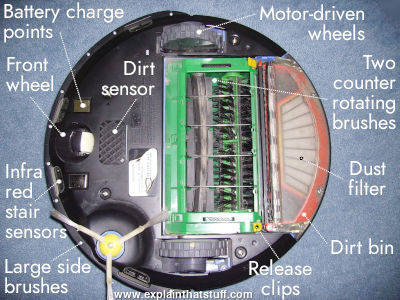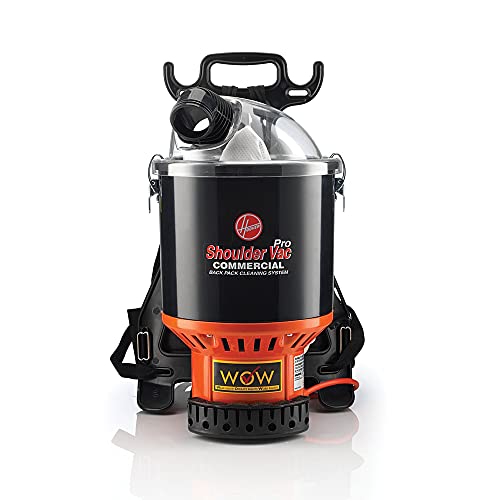How Does Robot Vacuum Work?

Robot vacuums work by using sensors to navigate around a room and identify areas that need to be cleaned. The vacuum then uses its brushes and suction to clean the floor.
We all know how frustrating it is to come home to a messy house. It seems like as soon as you tidy up, the messes just pile up again. But what if there was a way to keep your home clean without lifting a finger?
Robot vacuums are becoming increasingly popular for just this reason. But how do these little machines work? Robot vacuums use sensors to navigate around your home and identify areas that need to be cleaned.
They then use powerful suction to lift dirt, dust, and hair from your floors. Some models also include brushes that help loosen stubborn dirt and debris. Most robot vacuums can be programmed to clean on a schedule that works for you.
So you can set it to run while you’re at work or sleeping and wake up to a clean house! Some newer models even connect to your smartphone so you can start them cleaning with the push of a button – no matter where you are. The best part about robot vacuums is that they keep working even when you don’t have time to clean.
The Amazing Engineering behind the Cleaning Robots!
How Does Robot Vacuum Mapping Work
If you’ve ever wondered how those little robot vacuums manage to clean your floors so efficiently, the answer lies in their mapping capabilities. Robot vacuums use a combination of sensors and software algorithms to create a map of your home as they clean. This allows them to determine the most efficient cleaning route and avoid bumping into obstacles.
The first step in creating a map is for the robot vacuum to build up a basic understanding of its surroundings. It does this by using sensors to detect objects and identify changes in its environment. The vacuum’s sensors can include optical sensors, infrared sensors, or sonar sensors.
Once the vacuum has gathered enough data about its surroundings, it can start constructing a map. To create an accurate map, the vacuum needs to be able to identify landmarks that remain constant over time. These landmarks could be things like furniture or doorways.
The vacuum will use these landmarks as reference points when creating its map. As it cleans, the vacuum will continually update its map so that it can more accurately plot out future cleaning routes. Mapping technology has come a long way in recent years and some newer vacuums even have the ability to create 3D maps of your home.
This allows them to not only avoid obstacles but also plan more efficient cleaning patterns that cover all areas of your home evenly. So next time you see your robot vacuum zipping around your floors seemingly randomly, know that it’s actually following a very specific plan – one that’s designed to give you spotless floors with minimal effort on your part.

Credit: www.robotsscience.com
Does a Robot Vacuum Actually Work?
Robot vacuums have been around for a few years now and they are becoming increasingly popular. There are many different brands and models to choose from, but they all essentially work in the same way. You simply set them up in your home and let them do their job.
But does a robot vacuum actually work? The answer is yes, robot vacuums do work and they can be very effective at cleaning your floors. However, there are some things you need to keep in mind if you want to get the most out of your investment.
First of all, you need to make sure that your home is suitable for a robot vacuum. If you have a lot of carpets or rugs, then a regular upright vacuum cleaner might be better suited for your needs as it will be more powerful and have more suction. Robot vacuums are also not as good at cleaning edges and corners as traditional vacuums, so if these areas are particularly important to you then you might want to focus on them yourself or invest in a separate handheld vacuum cleaner specifically for these areas.
Overall though, robot vacuums can save you time and effort when it comes to keeping your floors clean – just make sure that your home is suitable first.
What is the Disadvantage of Robot Vacuum?
Robot vacuum cleaners are becoming increasingly popular, but there are some disadvantages to using one. One of the biggest disadvantages is that they can be expensive. Some models can cost several hundred dollars, which may not be affordable for everyone.
Another downside is that they may not clean your home as well as you would like. They can miss spots and leave behind dirt and dust. Finally, robot vacuums can be loud, which can be disruptive if you have young children or pets in the home.
How Does a Robot Vacuum Know Where It Is?
When you think about how a robot vacuum knows where it is, you might think of some kind of GPS system. But that’s not how these little devices work. Instead, they use sensors to map out the room and keep track of their location.
There are three main types of sensors that are used in robot vacuums: optical, acoustic and infrared. Optical sensors detect changes in reflection and can be used to create a map of the area. Acoustic sensors emit sound waves and measure the time it takes for them to bounce back.
This information is used to determine the distance between objects and help the vacuum avoid bumping into things. Infrared sensors pick up on heat signatures, which allows the vacuum to find its way back to its charging dock when its battery is low. So how do these sensors work together?
The optical and acoustic sensors work together to create a map of the room as the vacuum cleans. The infrared sensor is used mainly for navigation purposes, helping the vacuum avoid obstacles and find its way back to its docking station. By using all three types of sensors, robot vacuums are able to clean your floors quickly and efficiently.
Do Robot Vacuums Learn Your House?
Robot vacuums are amazing devices that can help keep your home clean. But do they actually learn your house?
The answer is yes and no.
Robot vacuums do have the ability to map out your home and create a virtual layout of it. This allows them to know where they’ve been and where they need to go next. However, this mapping is not perfect and sometimes robot vacuums can get lost or confused.
So while robot vacuums can learn the layout of your home, they are not perfect at it and still require some human intervention from time to time.
Conclusion
Robot vacuum cleaners are becoming increasingly popular, but how do they work? Robot vacuums use a combination of sensors and algorithms to navigate your home and clean your floors. They typically have a main brush that helps to loosen dirt and debris, as well as side brushes that help to reach tight corners and edges.




